|
|
|
You will then need to navigate back to this page using the County Index |
 |
||||||||||||||||||||||||||
East Riding | North Riding | West Riding |
||||||||||||||||||||||||||
Churches which still retain west gallery features or connections |
||||||||||||||||||||||||||
| Boynton, St Andrew | The church, with its 14th C. tower stands close to the hall gates at the end of the village street. The nave and chancel were rebuilt in 1768 by John Carr in Classic style. The tower contains a gallery, formerly the Squire's pew. (CEPC) | |||||||||||||||||||||||||
| Burton Agnes, St Martin | The church is close to both the mediaeval manor house and the Elizabethan mansion. [Burton Agnes Hall.] The remains of the Squire's pew can be seen, from which the fireplace was removed as recently as the early 1950s. Similarly, the gallery front has been incorporated into pews at the west end of the church. Some box-pews remain. (CEPC) | |||||||||||||||||||||||||
| Burton Fleming, St Cuthbert |
"Norman churchwardenised"
(CEPC)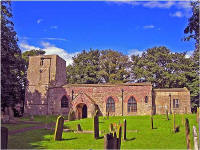 |
|||||||||||||||||||||||||
| Harpham, St John of Beverley | Norman church remodelled in the 14th C. Georgian fittings said to have been retained during the "restoration" of 1904-08, and these include a west gallery. | |||||||||||||||||||||||||
| Holme-upon-Spaldingmoor, All Saints | The 15th C tower overlooking treetops forms a landmark for the surrounding area. The church is mainly 15th and 16th centuries, with 17th C. brick parapets and porch. The interior is unspoilt, and contains a Jacobean pulpit with tester, 18th C west gallery (dated 1767) housing a 17th C. barrel-organ by J Hunton of York, early 18th C. "Gothick" pews, plain crown glass in the windows, Elizabethan black-letter texts on the east wall. (CEPC) | |||||||||||||||||||||||||
| Keyingham, St Nicholas | There is an iron hour-glass stand near the pulpit. | |||||||||||||||||||||||||
| Nafferton, All Saints | Rebuilt Norman chancel arch and font; old roofs and box-pews. (CEPC) | |||||||||||||||||||||||||
| Ottringham, St Wilfrid | The church contains box-pews. No further details available . . . | |||||||||||||||||||||||||
| Ruston Parva, St Nicholas | Tiny Gothic church of 1832 with box-pews. | |||||||||||||||||||||||||
| Sewerby, St John the Evangelist | The church is on the fringe of Sewerby Park and was built 1847 in the Norman style by Scott & Moffatt. The north transept was formerly the Squire's pew. "Gothic" style box-pews. | |||||||||||||||||||||||||
| Wintringham, St Peter | 12th C chancel with later windows, and Norman corbel table. 14th C nave and aisles. The pews are Jacobean, and there is a two-decker pulpit and alms box. | |||||||||||||||||||||||||
Churches which are known to have had west gallery features or connections |
||||||||||||||||||||||||||
| None so far known . . . | ||||||||||||||||||||||||||
 |
||||||||||||||||||||||||||
East Riding | North Riding | West Riding |
||||||||||||||||||||||||||
Churches which still retain west gallery features or connections |
||||||||||||||||||||||||||
| Aldfield, St Laurence | The parish church for Fountains Abbey. Three-decker pulpit. | |||||||||||||||||||||||||
| Brandsby, All Saints | Built 1767-70 by Richard Scurr, the architect being Thomas Atkinson. Any west gallery etc.?? | |||||||||||||||||||||||||
| Brotton, Old Church, St Margaret |
"Church built 1778. Cleveland
churchwarden classic". (CEPC) The old chapel of ease, dedicated to ST. MARGARET, was rebuilt in 1778 and is now used as a mortuary chapel. It is a plain rectangular stone edifice, measuring internally 67 ft. by 25 ft., with a tower 6 ft. square at the west end. It is lighted at the east end by a large round-headed window and by three similar but narrower windows on each side. The roof is covered with blue slates. The entrance is at the west end below the tower, which finishes with a low eaved pyramidal roof. Internally there is a flat boarded ceiling and a west gallery, approached through the tower from an external stone staircase. At the east end are two mural tablets, one of good design to William Tullie of Kilton, who died in 1741, with a long inscription, and a smaller one to Francis Easterby (d. 1804). There is also a stone in the floor to 'John Easterby Esq.' The interior was restored in 1873. ( http://www.british-history.ac.uk) |
|||||||||||||||||||||||||
| Carlton in Cleveland, St Botolph | Church built 1896-97. There is an open gallery over the vaulted ground floor stage of the central tower. | |||||||||||||||||||||||||
| Carlton Husthwaite, St Mary | This church contains a pulpit with sounding board. No further details available. | |||||||||||||||||||||||||
| *Coxwold, St Michael | Church with 15th C. exterior, the chancel being rebuilt in 1777. Several 17th and 18th century characteristics - west gallery, plasterwork on the east wall of the nave, box-pews, pulpit and monuments. # (CEPC ) | |||||||||||||||||||||||||
| Crayke, St Cuthbert | Mostly 15th C. The church has excellent pews, clerk's desk, church-wardens' seats, a pulpit dating from 1637, font cover and chancel chairs all dating from the 17th century. (CEPC ) | |||||||||||||||||||||||||
| Croft, St Peter | Standing on the south bank of the River Tees, the church is a long, low building dating from the 14th C. Elevated Milbanke pew looking like a box at the theatre. | |||||||||||||||||||||||||
| *Danby-in-Cleveland, St Hilda | 15th C. tower, the nave was "classicised" in the 18th C, and re-"mediaevalised" in 1903 by Temple Moore. The 18th C west gallery was retained, and is approached by an external flight of stone steps. There is a Royal Coat of Arms of George IV. (CEPC ) Canon Atkins wrote about this church and its history in Danby Dale | |||||||||||||||||||||||||
| Downholme, St Michael | A small country church high up on the south side of Swaledale. There is a stone-walled and grey stone-roofed building in the churchyard, possibly for stabling worshippers' horses. 17th C. porch, rood-loft window and a domestic-type window remain In the spandrels of the arcades are 18th C. painted texts. Many of the windows have clear glass in rectangular quarries. There are hatchments in the north aisle, box-pews in the chancel, two stoves and a fearsome 20th century pulpit. (CEPC) (CEPC ) | |||||||||||||||||||||||||
| Great Ayton, All Saints | The church was virtually replaced by the building of a new church, Christ Church, in 1876. The old church, however, contains a mixture between Norman and "18th century churchwarden" style, once very popular in the Cleveland area. The church furniture dates from 1790, and includes a three-decker pulpit with tester. (CEPC ) | |||||||||||||||||||||||||
| Grinton, St Andrew | In Swaledale, this church contains a pulpit with tester dating from 1718. | |||||||||||||||||||||||||
| Ingleby Arncliffe, All Saints | A little church which stands below the tree-covered slope of the Cleveland Hills, it was rebuilt in 1812 in "Cleveland churchwarden classical" style. It contains box-pews with their original painted numbers, a Scandanavian ship hangs from the roof, and there are Royal Arms of William III and George VI. (CEPC ) | |||||||||||||||||||||||||
| Kirkleatham, St Cuthbert | The church has an attached mausoleum on a plinth of rustic rocks, and forms an 18th C. group with the gates and gate piers of the churchyard, and the Hall opposite. Originally a mediaeval core, but rebuilt in 1763 by a local architect, Robert Corney. Internally there are Tuscan columns, cut-down box-pews, altar rails, pulpit and reading desk. The mausoleum is that of the Turner family, built in 1740 and rebuilt in 1839. (CEPC ) | |||||||||||||||||||||||||
| Marrick Priory | The remains of a Benedictine nunnery, part of it is now a farmhouse. It has a late 15th C. tower. The chancel is in ruins. The nave was pulled down in 1811 and rebuilt. There is, however, a Jacobean pulpit and box-pews. "all wearing an aspect of decay". (CEPC - 1958) | |||||||||||||||||||||||||
| Fylingdales, dedication not known | Church ca. 1821; there are north and west galleries. # | |||||||||||||||||||||||||
| Old Malton, St Mary | Pulpit with tester at east end. | |||||||||||||||||||||||||
| Osmotherly, St Peter | The mediaeval church was "churchwardenised", but further restored in 1892. No further details known. | |||||||||||||||||||||||||
| Redcar, St Peter | The west gallery here contains the 2m Gray & Davison organ which was used in Durham Cathedral during Scott's restoration of the Quire area, 1873 to 1876. It was subsequently transferred to a church in Middlesbrough, and thence to Redcar upon that church becoming redundant. | |||||||||||||||||||||||||
| Sherif Hutton, St Helen and the Holy Cross | "The interior is homely and intimate . . with brick floors, box-pews in which a good deal of mediaeval woodwork may be found, . . . 17th C. altar table and rails, Gurney stoves . . . " (CEPC) | |||||||||||||||||||||||||
| Skelton, Old Church, All Saints | 1785 Cleveland churchwarden classical style, with contemporary fittings. (CEPC) | |||||||||||||||||||||||||
| Stillington, St Nicholas | The church has late box-pews and the Royal Coat of Arms dated G. R. 1739. | |||||||||||||||||||||||||
| Wensley, Holy Trinity | Early benches and box-pews, and a great banner and hangings which form the Bolton family pew | |||||||||||||||||||||||||
| *Whitby, St Mary |
The great rectangular nave is filled
with box-pews and galleries which rise almost to the roof, and revolve around
the high pulpit with tester and reading desk. "The screen at the entrance to the chancel with its barley sugar Corinthian columns call to mind the Dutch Colonial churches in Ceylon (perhaps there is a connection?); whilst the precarious tiers of galleries echo what Ewan Christian swept away at Scarborough . . . " (CEPC) The Cholmeley pew above the chancel arch is late 17th C. West gallery circa 1700, north transept gallery 1744, south transept gallery 1759, nave gallery 1764, north aisle gallery 1818. Three external stairs lead to various galleries. # |
|||||||||||||||||||||||||
| York, Holy Trinity, Goodramgate |
SE 605 522
". . . Internally the church is one
of the most picturesque in York . . . the effect is produced by the
[box] pews, of
many dates, which heave and flow around the two-decker pulpit. 1785. . . .
" (CEPC) Their website is well worth a visit, and is at http://yorkholytrinity.org.uk/ The church is run by the Churches Conservation Trust. http://www.visitchurches.org.uk/ |
|||||||||||||||||||||||||
| York, St Michael-le-Belfry | Close to the west end of the Minster, this church dates from 1525-36 - a good example of a Hall-type town church (compare with St Andrew Undershaft, London) . It has a west gallery upon which are Royal Arms. | |||||||||||||||||||||||||
Churches which are known to have had west gallery features or connections |
||||||||||||||||||||||||||
| Redmire, St Mary the Virgin | Built about 1150, the perpendicular East window dates from the 15th century. The church was extensively restored in 1894 and changes have been made to the original fabric and furnishings on this and earlier occasions. Above the porch door on the outer wall of the church a now blocked up window existed to light a former choir gallery. | |||||||||||||||||||||||||
| Scarborough, St Mary | From contemporary drawings and water colours which hang in the church, the interior was comparable with St Mary's, Whitby, until Ewan Christian severely "restored" the church in 1848-50. See also | |||||||||||||||||||||||||
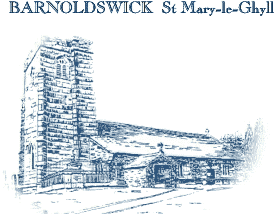 Secluded form township and highway in its own green 'ghyll', this treasured little church was founded by the monks who left Barnoldswick to establish Kirkstall. Externally, the wonderful roof, 16th century tower and quiet graveyard merit attention: the interior, with elegant box-pews facing a magnificent 3-decker pulpit, reflects an age when the preaching of the Gospel was all-important – a theme re-emphasised by the beautiful modern cover (work of a young local craftsman) on the 14th century font http://www.daelnet.co.uk/features/churches/skptpend/barlick.htm |
||||||||||||||||||||||||||
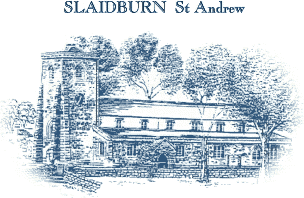 The amber stone of this historic church and village came from the surrounding fells through which the Hodder has carved a magnificent valley. The unusual, undisturbed Georgian arrangement of box-pews, the 18th century 3-decker pulpit, complete with fringed cushions, the ancient font, the exquisite carved screens and elegant chandeliers make this a church of special distinction. http://www.daelnet.co.uk/features/churches/skptpend/slaidbrn.htm |
||||||||||||||||||||||||||
|
Wharfedale
Daelnet, The Fleets, Rylstone, Skipton, North Yorkshire,
BD23 6NA, United Kingdom
|
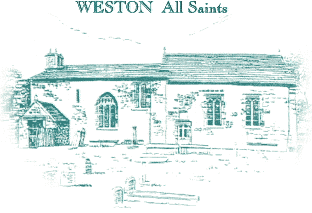 This ancient and hallowed building seems to merge into the natural scene. Its roots go back to Doomsday to Saxon and Viking times; the interior, however, is perfect 18th century, with 3-decker pulpit, box pews, Squires 'parlour' complete with fireplace 'for the comfort of his bride', and orchestra pew with central music stand. Early Medieval bells, Vavasour memorials, royal arms and 'lifeboat window' provide a unique range of interest. http://www.daelnet.co.uk/features/churches/wharfe/weston.htm |
|||||||||||||||||||||||||
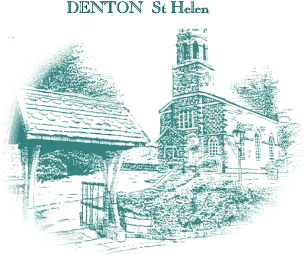 Designed by John Carr as a private chapel to Denton Hall (birthplace of the great Thomas, Lord Fairfax), this elegant little church stands in an immaculate village and parkland setting. The superb 'musicians'' window, signed by Giles of York and dated 1700, came from the Hall. There is other glass by Peckitt and from the famous Whitefriars workshop; also a wealth of armorial detail and fine inscriptions to enjoy. http://www.daelnet.co.uk/features/churches/wharfe/denton.htm |
||||||||||||||||||||||||||
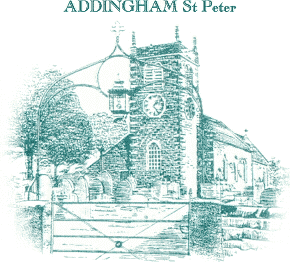 This neat little 18th century church stands amid an open field on an ancient site. A Saxon stone cross is a reminder of Archbishop Wulfhere's escape to Addingham in 867 when the Danes captured York. The nave roof, the arcade and chancel are 15th century; there is a quaint gallery of 1756 and plaques in memory of the Cunliffe Lister family. Visit the offical website at: http://www.addinghamrectory http://www.daelnet.co.uk/features/churches/wharfe/addinghm.htm |
||||||||||||||||||||||||||
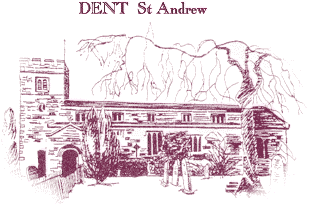 The twisty cobbled streets of Dent cluster round this imposing church on a high knoll of ground above the River Dee. Despite three restorations, many ancient features, come dating back to 900 years. The 17 th and 18th century pews bear the initials of the traditional "statesmen" of Dent, constructed in 1429 and still functioning. The illustrious Sedgwick family are commemorated in stained glass and inscription. |
||||||||||||||||||||||||||
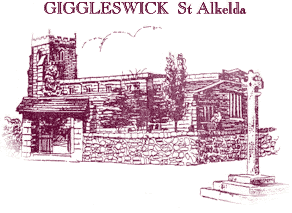 The history of this glorious, mellow church spans 1000 years. It witnessed violent days in the Scots raids of the 14th century, the Wars of the Roses and the Rising in the North, but for centuries was a religious stronghold for a vast area. Among a wealth of interesting items are three battered Tempest effigies and a 17th century pulpit, reading desk, communion rail and poor box of rare quality and curiosity. Dr Birkbeck of Settle, founder of Mechanics' Institutes, is commemorated here. http://www.daelnet.co.uk/features/churches/3peaks/gigglswk.htm |
||||||||||||||||||||||||||
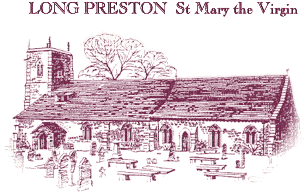 The long, low church with its elegant 18th century pinnacles stands back from the village among sheltering trees. Superb workmanship in stone and wood, combining strength with gracefulness and ranging from Norman to Georgian periods, makes it one of the gems of the area. There is a notable 18th century pipe organ, and exquisite 17th century pulpit and a marvellous black-and-white roof. http://www.daelnet.co.uk/features/churches/3peaks/lpreston.htm |
||||||||||||||||||||||||||
|
||||||||||||||||||||||||||
 |
||||||||||||||||||||||||||
East Riding | North Riding | West Riding |
||||||||||||||||||||||||||
Churches which still retain west gallery features or connections |
||||||||||||||||||||||||||
| Aldfield, St Lawrence the Martyr | 18th C. chapel of ease to Studley built in Gothick style, with box-pews and three-decker pulpit. | |||||||||||||||||||||||||
| Darrington, St Luke & All Saints | Transitional church, enlarged in 13th and 14th C. Unique Perpendicular gallery between chapel and north aisle opening by three arches on either side. (CEPC) | |||||||||||||||||||||||||
| Denholme Gate, St Paul | This Grade II listed church is sited between Denholme House and the A629, one mile south of Denholme, and stands within a rectangular churchyard. Designed by JB Chantrell, it was constructed in 1846 from coarse Gritstone blocks under a grey stone roof. The church remains very much as it was built, except for a modern extension containing a lavatory. It consists of a chancel (now vestry), north vestries, nave, north and south aisles, west gallery and west tower. The church is redundant. | |||||||||||||||||||||||||
| Dent, St Andrew | Late Perpendicular church of local type. "Quaint interior with box-pews, pulpit dated 1614. (CEPC) | |||||||||||||||||||||||||
| Farnham, St Oswald |
SE 35460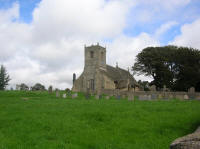 Picture D S Pugh, CC Licence - www.geograph.org There was a barrel organ of 1831, which in 1958 was still working, but noted by Langwill & Boston in 1970 as 'totally unplayable'. Moved to the Mechanical Instrument Museum, Chichester pre 1968. |
|||||||||||||||||||||||||
| Giggleswick, St Alkelda | 17th C. pulpit and reading desk. | |||||||||||||||||||||||||
| Holmfirth, Holy Trinity |
1787 "churchwarden" style, altered
in 1875. (CEPC) Galleries on three sides. 1875 galleries lowered three feet and new staircases built. Organ and choir moved from west gallery to chancel, and pitch pine pews replaced box pews. (Church Guide) |
|||||||||||||||||||||||||
| Kirk Bramwith, St Mary | Aisleless Norman church (chancel arch and south doorway) recast in "churchwarden" style . . . (CEPC) | |||||||||||||||||||||||||
| Leeds, St Peter, Kirkgate | Rebuilt 1839-41 by R D Chantrell of Leeds. Grade I, fine early Victorian church. 10th C Saxon cross; box pew galleries; Salviatti mosaics; monuments to worthies; new Jacob's ladder glass screen. Cafe. Exhibition of church textiles. | |||||||||||||||||||||||||
| Leeds, St John, Briggate | Church 1631-34, "Survival Gothic of twin nave plan". (CEPC). Has a pulpit with tester. | |||||||||||||||||||||||||
| Leeds, St Edward, Holbeck | Built by Bodley in 1903-04. There is a west gallery supporting the organ. | |||||||||||||||||||||||||
| Midhopestones, St James | A small 17th C. chapel with earlier fragments. There is a Jacobean pulpit, pews and a west gallery, possibly ca. 1705. The stair to the gallery has turned balusters.. | |||||||||||||||||||||||||
| Slaidburn , St Andrew | Perpendicular church with Jacobean screen, coarse 17th C. pewing, plain glass in windows, and a three-decker pulpit. | |||||||||||||||||||||||||
| Tong, St James | Five miles from the centre of Leeds and set amid lawns and trees, this church has Norman features and an almost entirely Georgian interior. There are box-pews and a three-decker pulpit. (CEPC). The church was rebuilt in 1727, and the gallery dates from 1731. | |||||||||||||||||||||||||
| Weston, All Saints | Norman walls and chancel arch and the interior largely untouched since the 17th century. Vavasour tomb and family pew. | |||||||||||||||||||||||||
Churches which are known to have had west gallery features or connections |
||||||||||||||||||||||||||
| Lightcliffe, Old Church, St Matthew |
SE 140255. Near
Halifax, the church was 1˝ miles north-north-west of
Brighouse on the north side of the A649. The Old Church at
Lightcliffe was, in spite of its name, the second of three
Anglican places of worship which have served the area, now
in effect a suburb of Halifax, since the sixteenth century.
It succeeded the Eastfield Chapel of 1529, which lay further
up the Wakefield Road. The sole survivor from that is a
stone now resited in the belfry of the residual tower. Built
in 1775, it was demolished in 1973. "The delicacy of
the quatrefoil columns supporting the gallery confirms them,
as observers did before demolition, as being in cast iron.
This makes them exceptionally early. Although Sir
Christopher Wren was responsible for the use of cast iron
columns as early as the 1690s in the House
 of
Commons, the earliest surviving example of this material as
gallery supports is at the church of
St James, Toxteth in Liverpool (now owned by the
Churches Conservation Trust). And the dates are virtually
identical: St James’s was begun in 1774 and finished 1775;
Lightcliffe seems to have been an exact contemporary. That
alone renders the destruction of the body of the church in
1973 lamentable. of
Commons, the earliest surviving example of this material as
gallery supports is at the church of
St James, Toxteth in Liverpool (now owned by the
Churches Conservation Trust). And the dates are virtually
identical: St James’s was begun in 1774 and finished 1775;
Lightcliffe seems to have been an exact contemporary. That
alone renders the destruction of the body of the church in
1973 lamentable.
For the full text of an article by Matthew Saunders, and pictures of what was an historic church, now lost to west galley enthusiasts, please read it at http://www.friendsoffriendlesschurches.org.uk/ The Friends of Friendless Churches have managed to preserve the tower, but the rest fell victim to the Pastoral Measure of 1969, which decided the fate of many disused Anglican churches. |
|||||||||||||||||||||||||
| Thornhill, St Michael & All Angels | Probably had all the usual Georgian fittings, which were removed in 1879 when church was "restored" by G E Street, and the nave destroyed. | |||||||||||||||||||||||||
Chapels which have or had west gallery features or connections |
||||||||||||||||||||||||||
| Bramhope, Leeds, "Puritan Chapel" |
A unique building, built
in 1649 for puritan worship on Robert
Dyneley's park land. Original furnishings, box pews,
3-decked pulpit. It is now no longer in regular use for
worship. See also the Parish Council web site at http://www.bramhope.org/brhistry.htm |
|||||||||||||||||||||||||
| Asterisks denote churches in preparation | ||||||||||||||||||||||||||
|
|